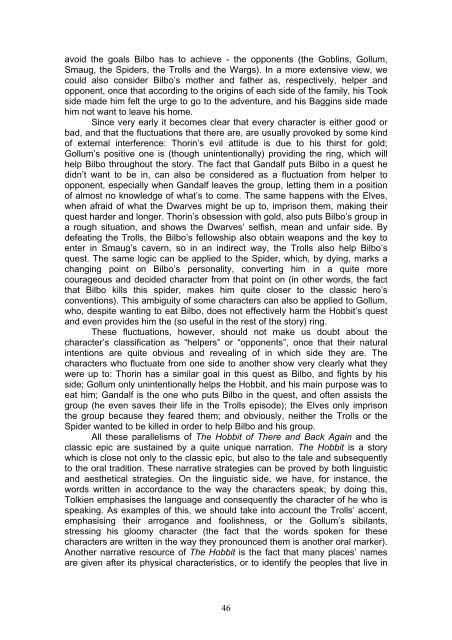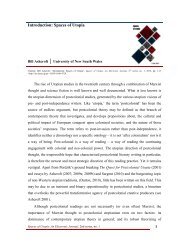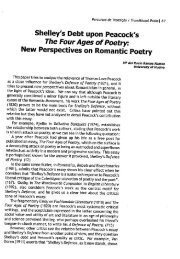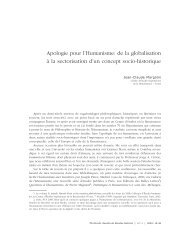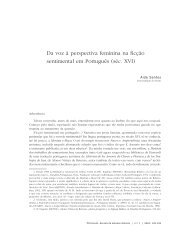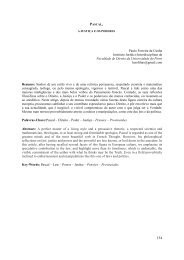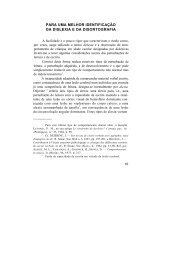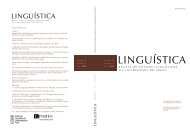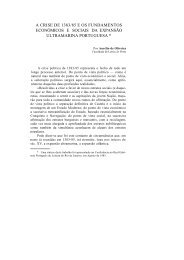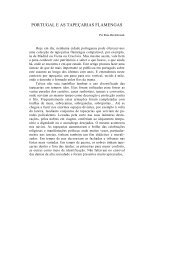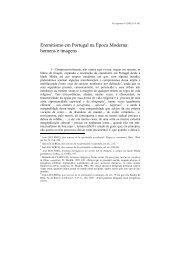Bilbo Baggins: An (Un)expected Hero
Bilbo Baggins: An (Un)expected Hero
Bilbo Baggins: An (Un)expected Hero
Create successful ePaper yourself
Turn your PDF publications into a flip-book with our unique Google optimized e-Paper software.
avoid the goals <strong>Bilbo</strong> has to achieve - the opponents (the Goblins, Gollum,<br />
Smaug, the Spiders, the Trolls and the Wargs). In a more extensive view, we<br />
could also consider <strong>Bilbo</strong>’s mother and father as, respectively, helper and<br />
opponent, once that according to the origins of each side of the family, his Took<br />
side made him felt the urge to go to the adventure, and his <strong>Baggins</strong> side made<br />
him not want to leave his home.<br />
Since very early it becomes clear that every character is either good or<br />
bad, and that the fluctuations that there are, are usually provoked by some kind<br />
of external interference: Thorin’s evil attitude is due to his thirst for gold;<br />
Gollum’s positive one is (though unintentionally) providing the ring, which will<br />
help <strong>Bilbo</strong> throughout the story. The fact that Gandalf puts <strong>Bilbo</strong> in a quest he<br />
didn’t want to be in, can also be considered as a fluctuation from helper to<br />
opponent, especially when Gandalf leaves the group, letting them in a position<br />
of almost no knowledge of what’s to come. The same happens with the Elves,<br />
when afraid of what the Dwarves might be up to, imprison them, making their<br />
quest harder and longer. Thorin’s obsession with gold, also puts <strong>Bilbo</strong>’s group in<br />
a rough situation, and shows the Dwarves’ selfish, mean and unfair side. By<br />
defeating the Trolls, the <strong>Bilbo</strong>’s fellowship also obtain weapons and the key to<br />
enter in Smaug’s cavern, so in an indirect way, the Trolls also help <strong>Bilbo</strong>’s<br />
quest. The same logic can be applied to the Spider, which, by dying, marks a<br />
changing point on <strong>Bilbo</strong>’s personality, converting him in a quite more<br />
courageous and decided character from that point on (in other words, the fact<br />
that <strong>Bilbo</strong> kills this spider, makes him quite closer to the classic hero’s<br />
conventions). This ambiguity of some characters can also be applied to Gollum,<br />
who, despite wanting to eat <strong>Bilbo</strong>, does not effectively harm the Hobbit’s quest<br />
and even provides him the (so useful in the rest of the story) ring.<br />
These fluctuations, however, should not make us doubt about the<br />
character’s classification as “helpers” or “opponents”, once that their natural<br />
intentions are quite obvious and revealing of in which side they are. The<br />
characters who fluctuate from one side to another show very clearly what they<br />
were up to: Thorin has a similar goal in this quest as <strong>Bilbo</strong>, and fights by his<br />
side; Gollum only unintentionally helps the Hobbit, and his main purpose was to<br />
eat him; Gandalf is the one who puts <strong>Bilbo</strong> in the quest, and often assists the<br />
group (he even saves their life in the Trolls episode); the Elves only imprison<br />
the group because they feared them; and obviously, neither the Trolls or the<br />
Spider wanted to be killed in order to help <strong>Bilbo</strong> and his group.<br />
All these parallelisms of The Hobbit of There and Back Again and the<br />
classic epic are sustained by a quite unique narration. The Hobbit is a story<br />
which is close not only to the classic epic, but also to the tale and subsequently<br />
to the oral tradition. These narrative strategies can be proved by both linguistic<br />
and aesthetical strategies. On the linguistic side, we have, for instance, the<br />
words written in accordance to the way the characters speak; by doing this,<br />
Tolkien emphasises the language and consequently the character of he who is<br />
speaking. As examples of this, we should take into account the Trolls’ accent,<br />
emphasising their arrogance and foolishness, or the Gollum’s sibilants,<br />
stressing his gloomy character (the fact that the words spoken for these<br />
characters are written in the way they pronounced them is another oral marker).<br />
<strong>An</strong>other narrative resource of The Hobbit is the fact that many places’ names<br />
are given after its physical characteristics, or to identify the peoples that live in<br />
46


